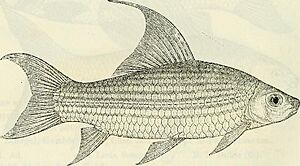Rednose labeo facts for kids
Quick facts for kids Rednose labeo |
|
|---|---|
 |
|
| Conservation status | |
| Scientific classification |
The rednose labeo (Labeo altivelis) is a type of fish. It belongs to the Cyprinidae family, which includes carps and minnows. This fish is also known by other names like Hunyani labeo or sailfin mudsucker. You can find the rednose labeo in parts of Africa. It lives in countries such as the Democratic Republic of the Congo, Malawi, Mozambique, Zambia, and Zimbabwe.
Contents
About the Rednose Labeo
This fish can grow to be about 27 centimeters (about 11 inches) long when it is fully grown. Some rednose labeos have been found to be much larger. They can reach up to 49 centimeters (about 19 inches) in length. The heaviest ones can weigh around 3.6 kilograms (about 8 pounds). These fish can live for up to nine years.
Where It Lives
The rednose labeo lives in many different rivers and lakes in Africa. These include the Congo, Luapala, Shire, and Zambezi rivers. It also lives in Lakes Mweru and Bangweulu. This fish likes to swim in deeper waters near the bottom of rivers and lakes.
What It Eats
The rednose labeo is a plant-eating fish. It mostly grazes on algae. Algae are tiny plant-like organisms that grow on rocks and other surfaces underwater. It also eats aufwuchs, which is a mix of small plants and animals found on surfaces.
Life Cycle and Migration
The rednose labeo is known for its special journey called a migration. This journey happens during the rainy season. The fish swim through the main rivers and into smaller streams called tributaries. In some places, like the Shire River in Malawi, they leave the swollen rivers. They swim out onto the floodplains, which are flat areas that get covered by water. This is where they lay their eggs.
Rednose Labeo and People
In some parts of Africa, the rednose labeo is an important fish for food. People often catch them during their spawning migrations. These events are sometimes called kapata. During this time, many adult fish gather in the shallow waters of the floodplains. This makes them easy to catch. The fish eggs are also collected and eaten, similar to caviar. Governments in some areas work to manage the fish population. This helps make sure there are enough fish for the future.


